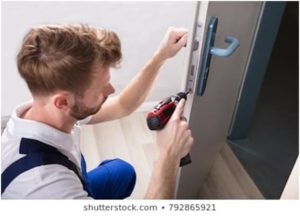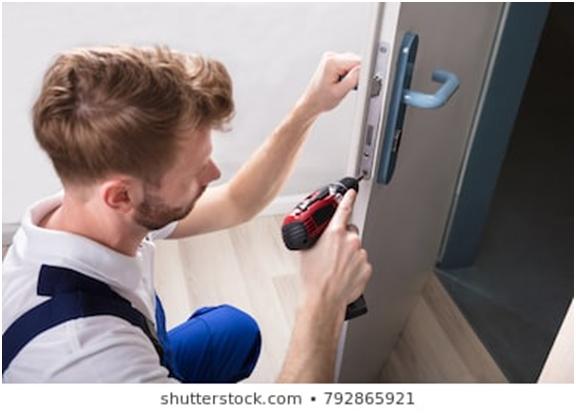If you have always wondered if a Yale lock reverse latch is really necessary for a door that opens outwards, here is you answer.
My first assignment at my new job as a locksmith’s assistant it to remove a bunch of locks from a residential property and re-install them at a commercial property. Unlike the residential property, all doors at the commercial property open outwards. I need to figure out how to reverse all the latches on the locks.
Image courtesy of Pixabay

As a general rule, lock manufacturers assemble locks with the latches fitted to suit inward opening doors. Most doors in residential properties open inwards. With inward opening doors, the beveled (sloping) edge of the latch faces outwards. This way the sloping edge hits the strike plate first, allowing it to smoothly retract and thenclick into position in the latch hole when the door is fully closed.
Inward Opening vs. Outward Opening Doors
You may be asking why some doors open inwardsand others open outwards. The broad answer to that is that it depends on the purpose of the spacethe door secures. In residential houses, bedroom and bathroom doors usually open into the room because there isn’t much traffic in and out of the room at any one time. Doors which serve small spaces like closets and utility rooms open outwards to maximize on space. Non-residential buildings which serve large numbers of people like auditoriums, business offices and restaurants have outward opening doors as a safety precaution. In the event of an emergency in which many people are trying to exit the room at the same time, it would be best to have an outward opening door. An inward opening door could see some people get trapped in the building in an emergency situation.
If you want to use your Yale lock on an outward opening door you will need a reversed latch in the lock. If you are purchasing a new lock, you can request a staff member at the shop to reverse it for you. For people who are ordering it online, you can always ask the supplier to reverse it before dispatch. If you are using an old lock, don’t worry, it is a fairly simple process.
How to Reverse a Yale Lock Latch
You will need a screw driver or drill and a pair of needle-nose pliers.
- Remove the two screws on the back of the lock. Be sure to hold the back plate down as you do this. Sometimes the spring inside the lock could make the plate fly off as soon as it is loosened.
- Pull the back plate off and set it aside.
- Use a pair of needle-nose pliers to disable the spring, remove it and set it aside. Needle-nose pliers are best because you can easily reach into the spaces in-between components and grip the spring. If you don’t have pliers, a pair of tweezers will work too.
- Lift out the bolt holding the latch and turn it around. Fix it back into position. You will now notice that the sloping edge of the latch appears to be facing the wrong direction
- Re-apply the spring
- Put the back plate and its screws back on
You now have your Yale lock reverse latch ready for installation. Don’t forget to buy a reverse strike plate. These are specially made for outward opening doors and can be purchased with a new lock or separately.
When you install the lock, you will notice that the sloping edgeof the latch faces inward. When the door is pulled or pushed towards the inside of the room to close it, it is the sloping edge that first comes into contact with the strike plate. It easily retracts to allow the door to close fully and then extends into the latch hole before you hear the familiar clicking sound which confirms that the latch is settled in the latch hole. If the latch had not been reversed, it is the square edge of the latch which would first come into contact with the strike plate when the door is closed. The latch would fail to retract and the door would not close as it should.
Final Say
If you are doing this for the first time and are not completely confident, use your cellphone camera to take pictures of the lock at every stage of the disassembly process. This way you can refer to them if you get stuck, wondering how one of the pieces should fit back in. Afterinstalling the lockon your outward-opening door, be sure to test the Yale lock reverse latch. Open and slowly close the door to confirm that the latch retracts and extends into the latch hole properly.
FAQ
Are there some Yale locks manufactured with an already reversed latch?
All Yale night latches and mortice locks are made for inward opening doors only. For an outward opening door, you have to reverse the latch yourself or ask the seller to do it for you. If you have an old lock you want to switch and can’t do it yourself, take it to a locksmith.
Some insurance companies insist that home insurance policy holders have BS – 3621 locks on their front door. Which Yale lock meets this standard?
The British Standard Night latch (High Security Range) meets this standard. Standard Security range night latches do not meet this standard.
Will reversing my Yale lock latch affect the spring on the latch?
No. As long as the spring is applied correctly when re-assembling the lock, the spring function should remain the same.
Can I get a reverse strike plate without purchasing a new lock?
Yes, you can purchase a reverse strike plate individually or along with a new lock.

